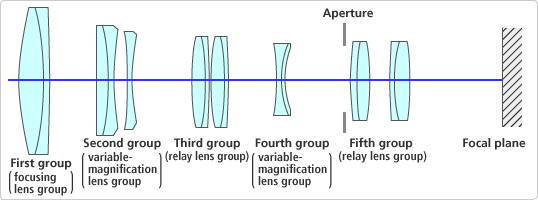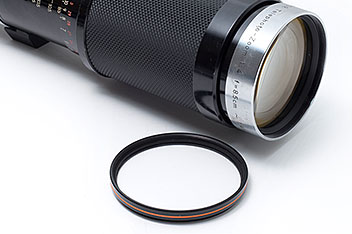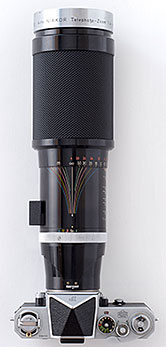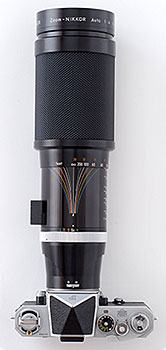
The Nikon F was the first single-lens reflex camera manufactured by Nikon (formerly Nippon Kogaku K.K.). It was released in April 1959. Four interchangeable NIKKOR lenses were released with the Nikon F: the 3.5cm f/2.8, the 5cm f/2, the 10.5cm f/2.5, and the 13.5cm f/3.5.
In August 1959, the company released the Auto NIKKOR Telephoto-Zoom 8.5-25cm f/4-4.5 (hereafter, the NIKKOR Zoom 8.5-25cm), with the first such lens purchased by a newspaper in December of the same year. The NIKKOR Zoom 8.5-25cm thus became the first ever telephoto zoom lens for still cameras.
The supposedly impossible zoom lens for still cameras

Auto NIKKOR Telephoto-Zoom 8.5-25cm f/4-4.5
(As it is a prototype, it differs somewhat in shape to the commercial product.)
Major specifications
Focal length: 85-250 mm
Maximum aperture: f/4-4.5
Lens construction: 15 elements in 8 groups
Closest focusing distance: 4 m (2.2 m when close-up attachment lens is used)
Attachment size: 82 mm
Tripod collar: attaches in two places to allow vertical and horizontal shooting
Weight: 1.8 kg
A zoom lens is a lens with a focal length that can be changed while focus remains on a fixed point. Since the focal length of a zoom lens can be changed, it can fulfill the roles of several single-focal-length lenses. In addition, since users are free to crop images by using different focal lengths, they can shoot pictures from any angle they please.
Although the merits of the zoom lens were already recognized, it had proved impossible to produce them with a high enough level of definition to enable their use with still cameras. In the 1950s, the use of zoom lenses was largely restricted to television cameras and to 8-mm and 16-mm movie cameras.
One European company had released a still-camera zoom lens prior to the launch of the NIKKOR Zoom 8.5-25cm. However, it had proved to be of very little practical use.
Design principles of the NIKKOR Zoom 8.5-25cm

A hand-drawn diagram from the time showing the internal structure of the Auto NIKKOR Telephoto-Zoom 8.5-25cm f/4-4.5
250 mm focal length (above); 85 mm focal length with close-up attachment lens (below)
The chief design principles of the NIKKOR Zoom 8.5-25cm were as follows:
- At any given focal length, the definition capability of the lens shall be comparable with that of an equivalent single-focal-length lens.
- Even when zooming in and out, the lens shall remain focused on a fixed point and the F-stop will not change. (At maximum aperture, the F-stop will change).
- The lens diaphragm shall have a fully automatic closing mechanism, so that the photographer will not miss out on photo opportunities.
- A depth-of-field scale with gradations corresponding to all focal lengths shall be included.
- The zooming operation shall be simple.
- The weight of the lens shall be low enough to allow hand-held shooting.
These principles have essentially been passed on and applied to today's zoom lenses. Thus, more than 50 years ago, Nikon was already in the process of establishing the concept of the zoom lens.
Nikon's proprietary "double-zoom" lens construction
The lens construction of the NIKKOR Zoom 8.5-25cm comprises 15 elements in eight groups. From the viewpoint of functionality, this lens construction can be divided into the following five groups.
Turning the focus ring moves the first group (the focusing lens group) forward and backward, enabling the lens to be focused. The movement of the zoom ring back and forth causes the second and fourth groups (the two variable-magnification lens groups) to move for variable-magnification effect. When the variable-magnification lens groups are closest to the subject, the focal length is 85 mm. When they are closest to the surface of the film, the focal length is 250 mm. Movement of the variable-magnification lens groups and the third group (the relay lens group) correct focus shift when the focal length is changed. Image size is fixed by the fourth group (variable-magnification lens groups), and the fifth group (the relay lens group) forms an image on the surface of the film.
A highly significant aspect of this lens construction is that it includes more than one variable-magnification lens group. It is not unusual for modern zoom lenses to feature multiple variable-magnification lens groups for purposes of high magnification and miniaturization. However, more than 50 years ago, at the dawn of the still-camera zoom lens era, Nikon was already developing a prototype lens that would be the forerunner of the modern-day lens using multiple variable-magnification lens groups. The man in charge of the development of the lens dubbed this a "double zoom" construction, since it included two variable-magnification lens groups. Without this construction the NIKKOR Zoom 8.5-25cm would probably have been even larger.

Lens construction of the Auto NIKKOR Telephoto-Zoom 8.5-25cm f/4-4.5
Optical design using a computer
Since high resolution is required of still-camera zoom lenses, proper correction for aberration is essential at every focal length. To this end, aberration-correction design work must be carried out—at least for the minimum, intermediate and maximum focal lengths. In other words, the design of a single zoom lens involves the same amount of effort as the design of several single-focal-length lenses. At the time, the technician in charge of development wrote "Completing the design of a single zoom lens is a rather arduous process."
Part of this process involved solving higher-order equations. At the time it was customary to perform calculations by hand—for example, using logarithmic tables. However, in this instance, manual calculation would have taken a colossal amount of time and would never have yielded the optimal solutions to these equations. Nikon first started using electronic calculators in 1953. Then, in October 1957, it began using the West German-made Zuse II computer, which had been adopted by U.S. and European manufacturers of optical devices. Using this computer, Nikon conducted research, development and design work on wideangle lenses and lenses of large maximum aperture, including the NIKKOR Zoom 8.5-25cm.


 From top to bottom, photos taken with a focal length of 85 mm, 135 mm and 250 mm respectively. The images on the right show movement of the zoom ring.
From top to bottom, photos taken with a focal length of 85 mm, 135 mm and 250 mm respectively. The images on the right show movement of the zoom ring.
Photo courtesy of Kominato Railway
A lens popular for its convenience

As the closest focusing distance is 4 meters, a close-up attachment lens was included with the lens. With this, the closest focusing distance became 2.2 meters.
If a NIKKOR Zoom 8.5-25cm were fitted to a camera, it could serve in place of multiple single-focal-length lenses and would spare the photographer the trouble of changing lenses. Newspapers and other press organizations were most appreciative of this convenience. As a result, the NIKKOR Zoom 8.5-25cm was used extensively by the press—despite the fact that it cost twice as much as the Nikon F itself.
On the first NIKKOR Zoom 8.5-25cm lenses sold, the rotary focus ring and linear zoom ring were operated separately (Image 1). From 1961 onwards, however, the lenses were sold with an integrated focus and zoom ring, and this yielded improved operability (Image 2). The direction the lens moved in to zoom was reversed, so that pulling the zoom ring back toward the camera increased focal length.
In 1969, Nikon launched a model with a maximum aperture of f/4 in any focal length, after improving the optical system. Millimeters, instead of centimeters, were used for the focal length indicator (Image 3).
 Image 1
Image 1
 Image 2
Image 2
 Image 3 (JCII Camera Museum collection)
Image 3 (JCII Camera Museum collection)
Establishing the telephoto zoom lens
Nowadays, the standard telephoto zoom lenses sold by lens manufacturers and camera manufacturers such as Nikon have focal length ranges of the order of 70 mm to 300 mm. Photographers make frequent use of focal lengths within this range and both professionals and amateurs alike greatly appreciate being able to take hand-held shots using a zoom lens. The NIKKOR Zoom 8.5-25cm was the first ever zoom lens to boast this focal length range and to achieve this level of usefulness. We hope that photographers will recall the NIKKOR Zoom 8.5-25cm whenever they shoot pictures using a telephoto zoom lens.
Compiled with the cooperation of JCII Camera Museum and Kiitos Corp., Inc.

